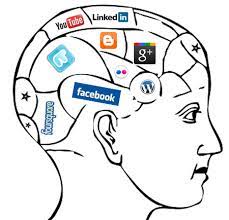I. Introduction
Social networking platforms have become integral parts of our lives, influencing how we connect, communicate, and share information. Behind the digital interactions lies a complex realm of psychological dynamics that shape online behavior. This article delves into the psychology of social networking, exploring the factors that drive human interactions, the impact of social media on mental health, and the evolving nature of online relationships.
II. The Social Brain and Online Interactions
a. Evolutionary Roots of Social Behavior
- Social Evolution: Human brains are wired for social connection, a result of evolutionary adaptations that favored collaboration and group living.
- Digital Extension of Social Instincts: Social networking platforms provide a digital extension of our inherent social instincts, allowing us to connect with others globally.
b. Psychological Gratification
- Social Validation: Likes, comments, and shares on social media platforms provide a sense of social validation, activating the brain’s reward system.
- Fear of Missing Out (FOMO): The fear of missing out on social activities drives increased engagement as users seek to stay connected with ongoing events.
III. The Impact of Social Media on Self-Perception
a. Social Comparison and Self-Esteem
- Filtered Realities: Social media often presents curated and idealized versions of individuals’ lives, leading to social comparison.
- Negative Effects on Self-Esteem: Constant exposure to curated content can contribute to feelings of inadequacy and lower self-esteem.
b. Cyberbullying and Mental Health
- Online Harassment: Cyberbullying on social media platforms can have severe consequences on mental health, leading to anxiety, depression, and in extreme cases, self-harm.
- Impact on Adolescents: Adolescents, in particular, are vulnerable to the negative effects of cyberbullying, affecting their self-image and emotional well-being.
IV. The Psychology of Online Relationships
a. Digital Anonymity and Disinhibition Effect
- Anonymity and Behavior: Users often feel a sense of anonymity online, leading to behaviors they might not exhibit in face-to-face interactions.
- Disinhibition Effect: Online disinhibition may result in both positive, supportive interactions and negative, aggressive behaviors.
b. Formation of Online Communities
- Shared Interests: Social networking platforms facilitate the formation of online communities based on shared interests, fostering a sense of belonging.
- Supportive Networks: Online communities can provide valuable support networks, aiding individuals facing challenges or seeking like-minded connections.
V. The Evolution of Social Media Trends
a. Visual Content Dominance
- Rise of Visual Platforms: Platforms emphasizing visual content, such as Instagram and TikTok, appeal to the human preference for visual storytelling.
- Impact on Communication Styles: The dominance of visual content influences communication styles, with images and videos playing a central role.
b. Short-Form Content and Attention Span
- Attention Economy: Short-form content aligns with the attention economy, where capturing and maintaining user attention is paramount.
- Implications for Information Consumption: The prevalence of short-form content shapes how users consume information, favoring concise and easily digestible formats.
VI. Navigating Social Networking for Positive Well-Being
a. Digital Well-Being Practices
- Mindful Consumption: Practicing mindful consumption involves being aware of the content we engage with and its impact on mental well-being.
- Setting Boundaries: Establishing healthy usage boundaries, such as designated screen-free times, helps maintain a balance between online and offline life.
b. Promoting Positive Interactions
- Digital Empathy: Practicing empathy online involves understanding and respecting diverse perspectives, contributing to positive digital interactions.
- Online Support Networks: Social networking platforms can be harnessed to create supportive online communities focused on mental health and well-being.
VII. Conclusion
Understanding the psychology of social networking is crucial in navigating the ever-evolving landscape of digital interactions. From the innate human need for social connection to the impact of social media on self-perception and mental health, the complexities of online behavior are vast. As social media trends continue to shape the digital space, fostering positive online experiences and promoting digital well-being become essential. By applying this understanding, users can engage with social networking platforms in ways that enhance rather than compromise their overall well-being.
FAQs
- Q: How does social media impact self-esteem?
- A: Social media can impact self-esteem through social comparison, where users may feel inadequate compared to curated content. Likes and comments can provide validation but may also contribute to a fear of missing out and lower self-esteem.
- Q: What is the disinhibition effect in online interactions?
- A: The disinhibition effect refers to the phenomenon where individuals may exhibit behaviors online that they would not display in face-to-face interactions. This can result in both positive and negative behaviors, influenced by a sense of digital anonymity.
- Q: How does short-form content influence online communication?
- A: Short-form content aligns with the attention economy, shaping how users consume information. Platforms emphasizing short-form content, such as Instagram and TikTok, have a significant impact on communication styles, favoring concise and visually engaging formats.
- Q: What are some practices for maintaining digital well-being on social media?
- A: Practices for maintaining digital well-being include mindful consumption, setting usage boundaries, and fostering positive interactions. Digital empathy and the creation of supportive online communities focused on mental health contribute to a healthier online experience.
- Q: How can individuals navigate social networking for positive well-being?
- A: Navigating social networking for positive well-being involves understanding the psychological aspects of online behavior, practicing mindful consumption, setting boundaries, promoting digital empathy, and creating or joining online communities that support positive interactions and well-being.
